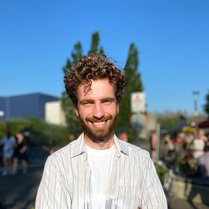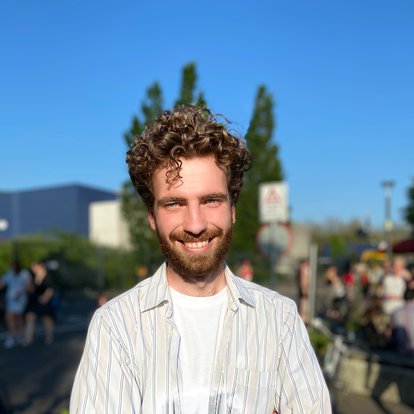For the public it often remains unclear what, when and if a camera monitors in public space. The Shuttercam project– part of our Responsible Sensing Lab with the City of Amsterdam– aims to shed light on how the design of cameras in public space can contribute to a ‘responsible’ Smart City.
Testing 3 Shuttercam prototypes at MALL
There are currently three different prototypes of the Shuttercam installed at Marineterrein Amsterdam Living Lab. The idea behind the shutter is that it makes it intuitive whether a system monitors or not – when the shutter is down, the vision of the camera is blocked; when the shutter is up, the camera is operational.
“By making the cap intuitively comprehensible, the Shuttercam prototypes enable people to check whether the sensing systems are operational, in a simple way and without the need for prior knowledge.”
Sjoerd Verhagen
Research Assistant
Smart sensors that do not see people
The “cameras” in this project are part of the crowd monitoring system of the City of Amsterdam, which enables the municipality to assess the crowdedness of a location. Based on their looks – the design – one could think these are (surveillance) cameras.
A crowd monitoring system works with a camera that has an algorithm read out and analyzes video images. In addition to measuring crowds and displaying those crowds in usable numbers, the algorithm can also determine whether people keep a distance of 1.5 meters. All this is done in an anonymous manner that complies with all privacy legislation.
The video images are not watched by a human but are processed automatically. Only a few frames are saved with unrecognizable, blurred people's faces. Those frames help to "train" the algorithm. Furthermore, the images are not saved.
What do visitors of Marineterrein Amsterdam think?
To test whether the Shuttercams are indeed understood intuitively by the public, we conduct explorative research at Marineterrein Amsterdam. During the first three weeks since we installed the prototypes, Sjoerd Verhagen, Research Assistant at our Responsible Sensing Lab, interviewed visitors of the test area to investigate how they:
(1) understand the function of the Shuttercam prototypes and if they think that this smart system is reliable
(2) perceive the Shuttercams as contributing to their experience of safety
(3) perceive the Shuttercams regarding their privacy
Initial thoughts on the Shuttercam prototypes
Although a lot of the passersby did not initially spot the Shuttercam prototypes, once made aware of their presence, most reactions were positive.
“Often you have to believe that you are measured anonymously, now there is a cap!”
Citizen of Amsterdam
Furthermore, the Shuttercams were predominantly perceived as reliable. A majority expressed their trust in the City of Amsterdam and felt that being transparent about what is measured is a step in the right direction.
Especially the “Opt-out Shuttercam” and “Winding Clock Shuttercam” were good starting points to think about cameras in the public sphere. While the Opt-out Shuttercam kickstarted thinking about consent, the Winding Clock model raised questions about the ownership of cameras.
“I think it creates awareness around what we’re doing. Now when someone leaves the company responsible for a camera, the transfer of the camera is done automatically.”
Citizen of Amsterdam
This is something that provides insight into how currently as citizens do not have any say in sensing systems in the city. As nicely summarized by a participant: “It is very easy nowadays for authorities to collect data – it is like a dragnet”.
First drawn conclusions
One central theme that arose during the first few weeks of research is that people do not have a strong notion of whatcrowd-control cameras actually measure. Several participants even perceived these crowd-monitoring devices as surveillance cameras. Thus, although the cap was intuitively understood, individuals might associate sensing devices with surveillance.
Furthermore, there were mixed results regarding Shuttercams adding to the experience of safety. Some felt that the addition of cameras only enhances distrust between people, while others were comforted by the idea of cameras.
On the topic of privacy, a majority felt that the Shuttercams were a step in the right direction. Still, participants were full of questions regarding who is collecting the data, what is exactly collected and for what purposes. Although this is explained on the panel next to the Shuttercams, most visitors did not notice this.
There was no real difference on the topic of privacy between the different prototypes of the Shuttercam. One take-away point is that the Opt-out and the Winding Clock Shuttercam provided some form of feedback, which was appreciated and provided food for thought about privacy.
What are our next steps?
For our next steps we explore how we can enhance the understanding and conspicuousness for what purpose the data is collected, stored and used.
Moreover, it is of importance to keep the public involved in this conversation, so that more responsible sensing can be developed.
A Responsible Sensing Lab project
Shuttercam is a project by Responsible Sensing Lab (RSL), a collaboration between the City of Amsterdam and AMS Institute. In essence, RSL is a testbed for conducting research and experiments on how smart sensing technologies in public space – like cameras – can be designed in a way that makes the digital city 'responsible’.

